There are all kinds of reasons you may be considering getting a soundbar to kick things up a notch in your TV room. The first, and most obvious, is that most TVs are lacking in the sound department, and a soundbar can bring fuller, bigger sound that can improve dialogue clarity and enhance your TV, movie, and gaming experiences. And that’s just the basics.
With such a wide variety of soundbars available, they can deliver room-filling immersive sound with Dolby Atmos support while others come with subwoofers and additional surround speakers you can mount on a wall to save space, and some are even wireless. Some have big booming volume while others are more suited to smaller rooms like apartments, and some are just designed to blow you away completely, like the 3,000-watt Nakmichi Dragon. There’s a soundbar for every situation and budget.
But when it comes to sheer versatility and performance, the Sonos Arc is the whole package. The Arc is compatible with Dolby Atmos, it has room-filling sound, it’s expandable, it doubles as a smart speaker, and there’s nothing like it on this list when it comes to multiroom audio. It’s certainly not the cheapest soundbar you’ll find, but once you consider its many strengths, it’s hard to deny the value Sonos provides with the Arc.
That’s not to say it’s the only soundbar out there worth your hard-earned cash, though. Far from it, in fact. We’ve stocked this list with multiple other recommendations for you to check out, so you’ll have plenty of options to find the right soundbar for your setup and preferred media.
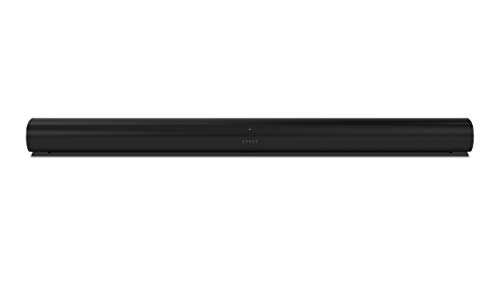



Sennheiser Ambeo Soundbar Plus
The best Dolby Atmos sound from a single speaker
Jump to details

Vizio Elevate 5.1.4 Home Theater Soundbar
The best Dolby Atmos for under $1,000
Jump to details


Samsung HW-Q990B Dolby Atmos Soundbar
The best home theater replacement
Jump to details
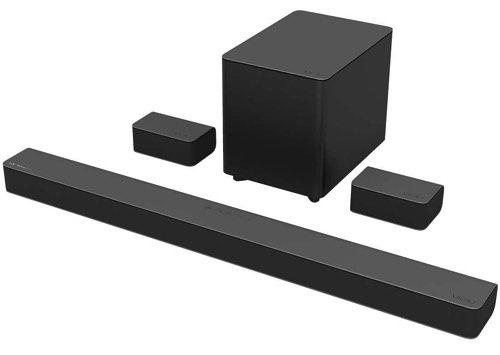
Vizio M-Series 5.1 soundbar (M51a-H6/M51ax-J6)
The best budget soundbar
Jump to details


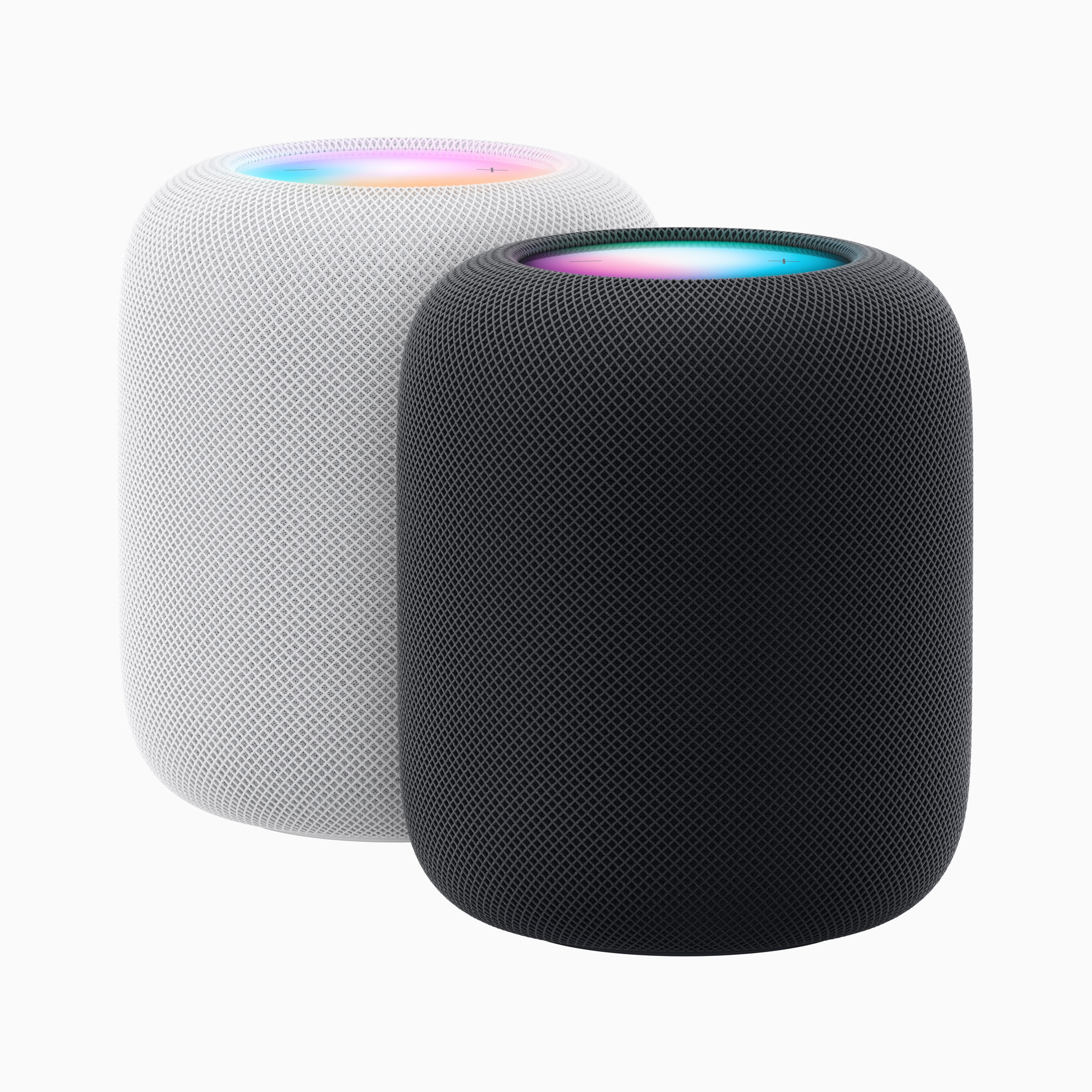
Apple HomePod (2nd Gen)
Best soundbar alternative for Apple TV fans
Jump to details

Nakamichi Dragon 11.4.6 surround sound system
Best no-holds-barred, money-is-no-object soundbar
Jump to details
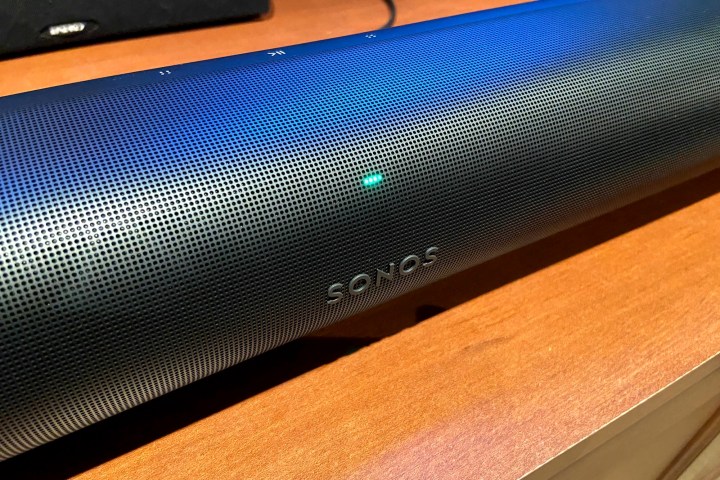
Simon Cohen / Digital Trends
Sonos Arc
The best overall soundbar
Pros
Excellent surround sound
Easy and simple setup
Decent Dolby Atmos from a single speaker
Choice of Alexa or Google Assistant
Cons
No HDMI inputs
Not ideal for all music genres
At the risk of sounding too sensational, the Sonos Arc embodies everything Sonos is about. It’s incredibly easy to set up and use, it provides great sound, and it seamlessly incorporates itself into your larger network of whole-home Sonos sound. With all of that packed in, it would have been easy for Dolby Atmos to be an afterthought.
Quite the contrary, as it turns out. The Arc uses up-firing drivers to re-create Dolby Atmos sound, adding a solid sense of 3D space to action films, sports, and more. On its own the Arc is impressive, but you can easily expand its home theater capabilities by adding other Sonos speakers as surround satellites, such as a pair of Play Ones or even Sonos’ latest and greatest, the Era 100 and Era 300 speakers, the latter of which also fires out incredible Dolby Atmos sound. Plus, you now have two choices for low-frequency effects: the magnificent — if very expensive — Sonos Sub and the new, smaller Sub Mini. HDMI eARC connectivity makes the Arc a breeze to add to your TV and set up.
The Sonos Arc is also a smart speaker, with three choices of voice assistant: the bare-bones but super useful Sonos Voice Control for Sonos-only functions, plus Alexa and Google Assistant, which can control Sonos products and much more, too.
Additionally, the Sonos Arc is terrific for listening to music. The Sonos app gives you an incredible amount of control over the Arc (and any other Sonos speakers in your home), with access to all kinds of music streaming services, including Dolby Atmos Music tracks, which sound unreal on the Arc, especially if you were to add those Era 100s or Era 300s to the mix.
All around, the Sonos Arc will take your TV to the next level and deliver a fantastic music-listening setup as well.

Sonos Arc
The best overall soundbar

Riley Yong/Digital Trends
Vizio M-Series AiO
The best soundbar for $200 or less
Pros
Great fidelity for the price
Excellent dialogue clarity
Wide soundstage
Ample bass
Good dynamics
Cons
No perceived Dolby Atmos effects
When you get right down to it, people buy soundbars because they want better sound from their TV, but they’re not interested in all of the convoluted wiring, settings, or the expense involved in going with a full home theater system. And when it comes to delivering on that goal for the least amount of money, Vizio’s 2023 M-Series AiO is a slam-dunk.
It starts with a single speaker, which is compact and understated — no flashy metal finishes or exposed drivers — just an elegant trapezoid wrapped in dark gray fabric. Getting it connected is a cinch — just plug it into your TV using the included HDMI cable, or you can use your own optical cable. That’s it.
The included remote makes it easy to control (or thanks to HDMI eARC, you can control it with your TV remote), and if you own a Vizio TV, all of the key settings will be merged into your TV’s on-screen menus, which is a great addition, and something you rarely see on any soundbar regardless of price.
The M-Series’ audio chops are impressive, especially the bass response, which surprised our reviewer Caleb Denison with its power. In his estimation, it’s better than what many cheaply-built wireless subwoofers offer, so you won’t miss that extra black box at all. Dialog in movies is crisp and clear, so you won’t be leaning across to your friends and family to whisper, “What did she just say?”
You get an HDMI input, and the M-Series has a special trick up its sleeve for folks who want to wall-mount it. Sensors inside automatically reconfigure the tuning of the drivers to ensure you get the best sound, even when the speaker is oriented with its top facing you.
There’s only one real caveat with the M-Series AiO: Despite being labeled as Dolby Atmos-capable, our reviewer wasn’t able to discern much in the way of a 3D sound experience when listening to Atmos content. Is it a deal-breaker? No — at this price, we don’t expect any Dolby Atmos soundbar will perform significantly better. If Dolby Atmos on a budget is your goal, check out the Vizio M-Series 5.1 soundbar (M51a-H6/M51ax-J6) farther down on this list.

Vizio M-Series AiO
The best soundbar for $200 or less
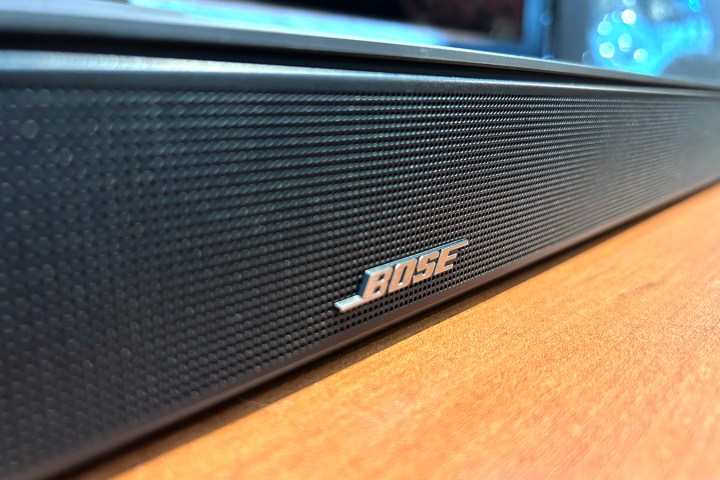
Simon Cohen / Digital Trends
Bose Smart Soundbar 600
The best small soundbar
Pros
Easy setup
Excellent Atmos for its size
Clear and engaging dialog
AirPlay and Chromecast
Good music quality
Cons
No HDMI inputs
Smart speaker is Alexa-only
Limited in-app music services
When compared to Sonos, Bose still has a ways to go when it comes to multiroom sound and streaming music service integration, but thanks to the 600’s built-in up-firing height drivers, it’s the best small speaker for movies and TV — especially if Dolby Atmos is involved.
Bass and dialog clarity are two especially bright spots for the Smart Soundbar 600, but it’s the sheer size of the speaker’s soundstage that you notice the most. It projects sound upward, outward, and to the sides so effectively, you’ll swear there are additional speakers in your room. If the effect isn’t powerful enough, you can add the real deal — the 600 is compatible with two models of wireless Bose subwoofers and two models of wireless Bose surround speakers.
Like its predecessor, the Smart Soundbar 300, and the Sonos Beam Gen 2, the 600 can act as a smart speaker, but only using Amazon’s Alexa AI. Google Assistant is still compatible, but it’s no longer built-in. However, you do get Chromecast in addition to AirPlay and Bluetooth, making the Smart Soundbar 600 a better streaming choice for Android users than Sonos (AirPlay only).
The Smart Soundbar 600 also has a feature that’s custom-tailored to bedrooms: You can connect any compatible Bose headphones over Bluetooth for private listening.
We still love the Sonos Beam Gen 2 — and strongly recommend it if you’re looking to build or expand a multiroom wireless audio system — but for immersive sound, the leader right now is Bose. Additional honorable mention goes to the Sony HT-S2000, which excels at Dolby Atmos sound for around the same price, but lacks some of the 600’s features such as voice assistants and connectivity.

Bose Smart Soundbar 600
The best small soundbar
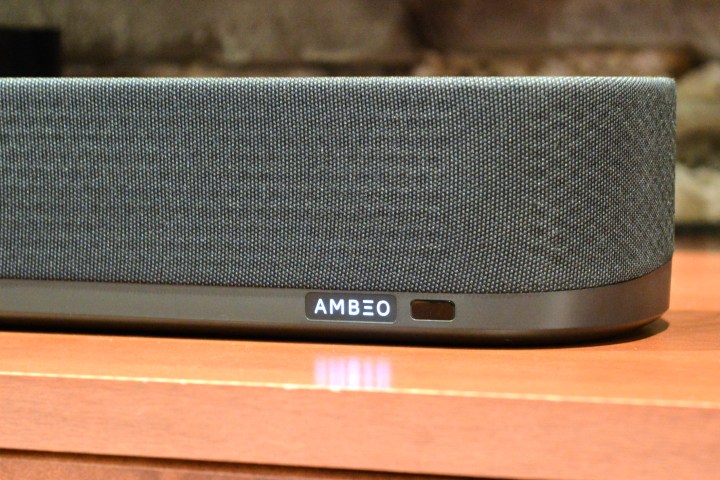
Simon Cohen / Digital Trends
Sennheiser Ambeo Soundbar Plus
The best Dolby Atmos sound from a single speaker
Pros
Fantastic 3D sound
Lots of connections
Built-in room tuning
Up to 4 wireless subs/1 wired sub
AirPlay/Chromecast/Tidal Connect
Alexa built-in
Dolby Atmos/DTS:X
Sony 360/MPEG-H
Cons
Still expensive
Only HDMI 2.0a
Relies heavily on mobile app
Weird Alexa integration
If you want to get the most immersive and powerful sound possible from a soundbar — with no subwoofers or extra surround speakers — the Sennheiser Ambeo Soundbar Plus is without equal. Its secret sauce is the Ambeo digital signal processing that Sennheiser pioneered with its first soundbar, the recently renamed Ambeo Soundbar Max.
You can think of Ambeo as a turbo-charger for immersive, 3D audio. Using the Soundbar Plus’ nine drivers and amps, it projects sound around even large rooms in such a way that you become convinced there must be speakers hiding behind your furniture or in your ceiling. It truly brings Dolby Atmos, DTS:X, and even two-channel stereo to life in a way that is nothing short of mesmerizing. To get even close to this effect, most soundbars need to add additional surround speakers, and even then, they don’t always succeed.
With two HDMI 2.0a inputs (plus optical and analog ports) and an HDMI 2.1 ARC/eARC input/output, there’s no need to give up ports on your TV. And with the option to use Sennheiser’s wireless Ambeo subs (up to four) or your own wired subwoofer, you’re not locked in to a specific accessory for low-end power. Its support for AirPlay, Chromecast, and Bluetooth means you’re free to stream music to the bar from any device you own. And if you want to use it as a smart speaker, Amazon Alexa is built-in and can be turned on at any time.
At $1,500, it’s one of the more expensive soundbars. And despite being able to add it to Google Home or Amazon Alexa, it’s not a great choice for multiroom sound. But when you take into account its remarkable performance as an Atmos speaker, it’s worth every penny. For a more powerful (but considerably larger) option, see the Sennheiser Ambeo Soundbar Max.

Sennheiser Ambeo Soundbar Plus
The best Dolby Atmos sound from a single speaker
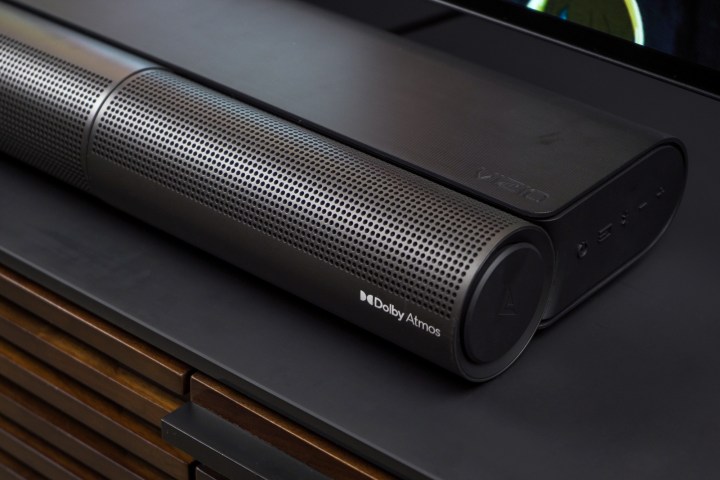
Riley Young/Digital Trends
Vizio Elevate 5.1.4 Home Theater Soundbar
The best Dolby Atmos for under $1,000
Pros
Simple setup, clear chart showing connections
Wonderfully unique design
Deep control over sound output levels
Exceptionally clear dialogue
Cons
Effects dependent on room
Costly
Vizio appears several times on this list, and for good reason. The company has a huge (though sometimes confusing) array of soundbars at a variety of prices for every budget and room size. The Elevate is the company’s flagship and it deserves serious consideration by anyone who wants an elegantly designed and powerful sound system for their TV.
The Elevate’s signature feature is its rotating speaker modules. They sit at the ends of the soundbar and rotate from front-firing to up-firing whenever Dolby Atmos or DTS:X content is being played. When combined with the up-firing drivers embedded in the surround speakers, you get four height channels, for overhead sound effects that get surprisingly close to the more expensive Samsung HW-Q990B. Better yet, all of those 5.1.4 channels are individually controllable, so you can easily tune the speakers to your space.
The included wireless subwoofer has a generous eight-inch driver and can reach as low as 30Hz, and has enough power to rattle your windows, even if it can’t quite compare to the dedicated powered subs you’ll find on more expensive component systems.
With two HDMI inputs and an HDMI ARC/eARC output, there’s no problem with being able to attach external media sources, and Bluetooth is on tap for streaming music from your phone. The only thing missing is Wi-Fi, so there’s no support for high-quality audio streaming from music services, no compatibility with AirPlay, Chromecast, or Amazon Alexa, and no multi-room audio.
Still, for the price, it’s very hard to beat the Elevate for pure TV and movie immersion. The only thing that comes close is Vizio’s own M-Series Elevate, which is $200 cheaper and lacks the flagship Elevate’s rear up-firing drivers.

Vizio Elevate 5.1.4 Home Theater Soundbar
The best Dolby Atmos for under $1,000

Simon Cohen / Digital Trends
Sony HT-A5000
The best for music and gaming
Pros
8K-ready HDMI input
Excellent movie and music sound
Easy on-screen setup
Tons of connection options
Hi-res, Sony 360RA, and DTS:X
Cons
No EQ adjustments
Some settings are buried
Poor integration of music services
If you’re looking for a soundbar that can do a terrific job with movie and TV audio as well as advanced music playback, we think the Sony HT-A5000 is the speaker to beat.
It starts with a very well-appointed (if somewhat plainly styled) soundbar, that packs its own built-in subwoofer. That driver is powerful enough that unless you’re looking to shake your fillings loose, you probably don’t need a dedicated sub. Sony’s virtual surround technology does a very good job creating an immersive sound field when listening to Dolby Atmos or DTS:X content, but it does a surprisingly good job upscaling regular two-channel content too. But the A5000’s secret sauce lies in its connections and audio compatibility.
With Wi-Fi, AirPlay 2, Chromecast built-in, and Bluetooth (send and receive), it doesn’t matter what kind of device you’re holding in your hand — you’ll be able to stream its audio content in the highest possible quality to the A5000. Better yet, Sony has included support for a huge variety of audio formats and qualities, from the lowliest MP3 files all the way up to hi-res 24-bit/96kHz FLAC and DSD tracks. You can play these files from a USB storage device, your home network, or virtually any streaming service that supports HD audio like Tidal, Amazon Music, or Apple Music. Want to explore the worlds of Dolby Atmos Music and Sony 360 Reality Audio (360RA)? The A5000 has you covered there too.
Even Bluetooth — normally the lowest-quality wireless audio link — has received an upgrade in the form of LDAC codec support. When connected to an LDAC-capable phone (mostly Android handsets), you’ll get audio fidelity that almost rivals Wi-Fi.
That support for high-quality audio extends to the A5000’s HDMI input. It can passthrough 8K and Dolby Vision, which is awesome for future-proofing, and with 4K @120Hz it’s a good choice for gaming too. But it’s even better news for those whose TVs don’t support HDMI eARC: You’ll still be able to get the very best, lossless version of Dolby Atmos by plugging your Blu-ray player or Nvidia Shield TV into the soundbar directly, thereby avoiding the down-conversion that some older TVs will do to Dolby Atmos content.
Add to this Sony’s excellent on-screen menus and setup process, auto-room calibration, and tight integration with Sony Bravia TVs and you’ve got a soundbar that easily justifies its admittedly high $1,000 price. The only thing we wish Sony had included is the ability to adjust the HT-A5000’s sound EQ parameters.

Sony HT-A5000
The best for music and gaming
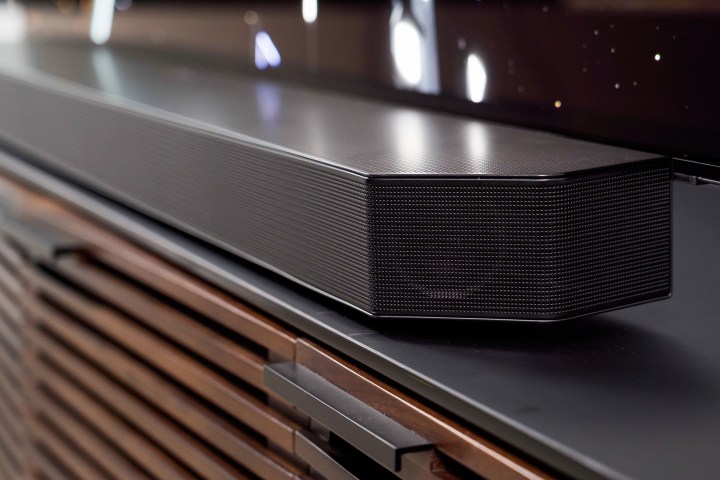
Image used with permission by copyright holder
Samsung HW-Q990B Dolby Atmos Soundbar
The best home theater replacement
Pros
Excellent fidelity
Impressive Dolby Atmos effects
Solid bass performance
Granular-level controls
Handles large rooms easily
Cons
Power cords are too short
While soundbars can be very attractive because of their simplicity, more and more folks want them to be genuine home-theater-in-a-box, complete sound systems, and the Samsung HW-Q990B goes further than any other system toward meeting that goal.
With its included wireless subwoofer and surround speakers, the Q990B pumps out an astonishing 656 watts of power via 22 discrete drivers in an 11.1.4 configuration. It’s a system that is capable of amazing Dolby Atmos and DTS:X sound. We had originally selected LG’s excellent S95QR for this category, but once we heard the Q990B, it was no contest. To quote our reviewer, “Once I dialed this system in for my setup and this room? It was nothing short of outstanding.” He also noted that the soundbar’s center channel clarity — key for dialog reproduction — was the best he’d ever heard on a soundbar.
You get two HDMI 2.1 inputs with 4K/HDR10+ passthrough (though notably, not Dolby Vision), so even if your TV’s HDMI ports are full or it doesn’t support Dolby Atmos, you’re covered — just plug a streaming device or game console into the soundbar and you’ve got the best sound and video on tap. If your TV is also a recent Samsung model, you get the benefit of wireless Dolby Atmos (no need to run an HDMI cable to the TV) and Q-Symphony, which lets the TV’s speakers augment the soundbar instead of sitting there unused.
With Wi-Fi connectivity, Apple AirPlay 2, and Alexa built-in (plus Bluetooth, naturally), there are plenty of ways to stream music to this system.
It can be a bit daunting to work your way through all of the menus and options, but Samsung’s Smart Things app for iOS/Android makes the task a bit easier. When it’s all dialed in, you’ll be thrilled with the sound. This is as close as a single product in a box can get to a fully installed component system.
If it’s a home theater replacement you’re after, we also strongly recommend you check out the Klipsch Cinema 1200, an absolute beast of a system that packs enough power to give many AV receiver-based setups a run for their money.

Samsung HW-Q990B Dolby Atmos Soundbar
The best home theater replacement

Dan Baker/Digital Trends
Vizio M-Series 5.1 soundbar (M51a-H6/M51ax-J6)
The best budget soundbar
Pros
eARC, Dolby Atmos, DTS:X support
Impressive subwoofer
Seamless surround effects
Comprehensive control
Excellent fidelity
Cons
One HDMI input
Less suitable for larger rooms
The Vizio M-Series looks like a typical soundbar at 36 inches in length, and its 6-inch wireless subwoofer looks like many others. But what helps this model stand apart is its more reasonable price and its versatility.
If you have a medium-to-large room, you can place the subwoofer toward the rear of the space which lets you position the wired surround modules behind the viewing area. But if you’ve got a smaller space, you can put the sub near the front — the M-Series will automatically calibrate the system to give you the best sound possible.
But that’s putting the cart before the horse. The M-Series sounds amazing, with clear highs and mids for dialog, and precise bass response. With support for both virtualized Dolby Atmos and DTS Virtual:X, you may not get quite the jaw-dropping overhead sounds that you’ll find with up-firing soundbars like the Arc or the Ambeo, but it’s a much more immersive experience than a traditional 5.1 setup.
Because of its HDMI eARC port, the M-Series can support much higher bandwidth, lossless hi-res audio when connected to a compatible TV. An extra HDMI input means that you’re not forced to give up an input on your TV.
There’s also the usual complement of connections, including Bluetooth, optical in, and a USB port for removable drive-based audio files.
The only real caveat with the M-Series is the lack of Wi-Fi. This means you can’t stream music to it via AirPlay or Chromecast, and it can’t be controlled via voice assistants like Alexa and Google Assistant. But that one aspect notwithstanding, the Vizio M-Series is an outstanding choice for anyone who wants fun, room-filling surround sound without breaking the bank.

Vizio M-Series 5.1 soundbar (M51a-H6/M51ax-J6)
The best budget soundbar
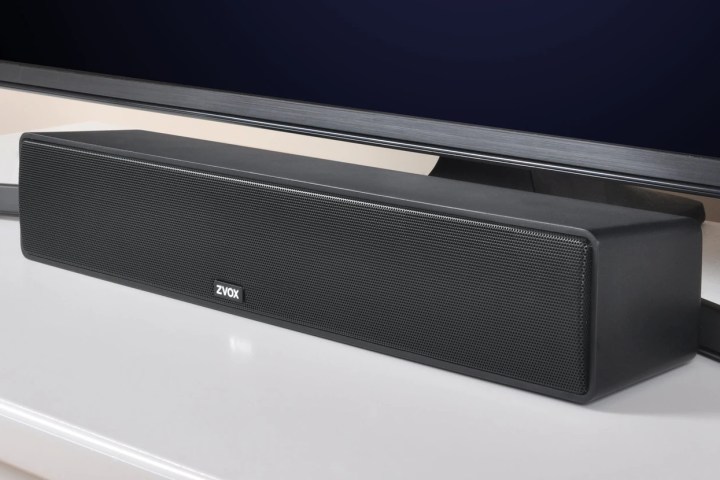
Zvox
Zvox AV157 TV Speaker
The best for dialog enhancement
Pros
Small footprint
Easy connections and setup
Super-clear and adjustable dialog
Cons
Expensive for a small speaker
No wireless connections for music
The AV157 packs six levels of Zvox’s AccuVoice technology for speech enhancement and an additional six levels of its SuperVoice tech for a huge range of assistance for those who are hearing-impaired or who just struggle to separate speech from other sounds.
The 12 levels of AccuVoice and SuperVoice determine how pronounced this effect is. At its most powerful, the AV157 can deliver speech so clear and precise, it’s almost painful. But for those who suffer from hearing loss, it will be a pleasure.
But better dialog is only the beginning. The AV157 is also a surprisingly capable movie and music speaker too. Turn on the surround sound mode and it does a decent job with all kinds of immersive soundtracks.
Bass performance doesn’t quite measure up to full-size soundbars, but it’s solid and well-balanced. Should you want to get a bit more rumble, you can add an external wired subwoofer using the analog sub-woofer output.
Connections are modest: You can use an optical cable or an analog cable to connect the AV157 to your TV, and there’s no Bluetooth or Wi-Fi. But this keeps things simple and you won’t have to give up an HDMI port just to get better sound from your TV.
The included remote is also a simple but effective device, with large, easy-to-press, and clearly labeled buttons.
If you’re tired of relying on subtitles to understand what your favorite actors are saying, the Zvox AV157 is a perfect TV companion.

Zvox AV157 TV Speaker
The best for dialog enhancement
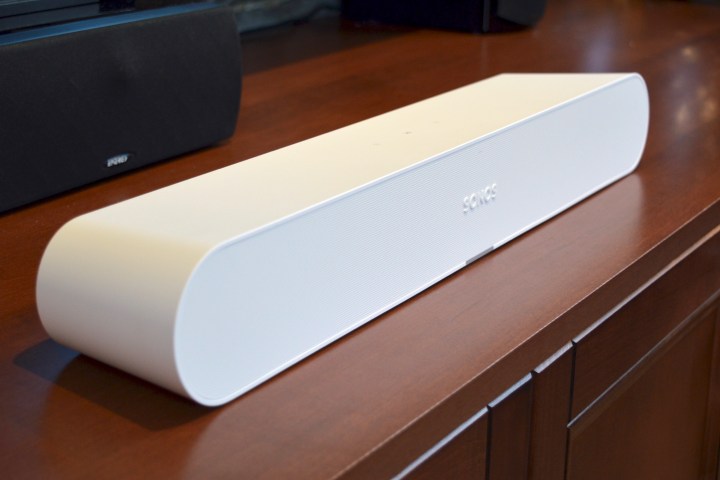
Simon Cohen / Digital Trends
Sonos Ray
Best Sonos for smaller rooms and smaller budgets
Pros
Compact for versatile placement
Impressive sound for its size
Expandable to a full 5.1 system
Easy setup and control
Cons
Pricey for a small soundbar
Lacks a bit of midrange detail
So you’ve wanted to get into Sonos for your TV room, but your room’s a bit too small for the big sound and bigger price of its flagship Sonos Arc (on our list above) or even the middle-tier Beam (2nd gen). In 2022 Sonos finally addressed this need and launched the Sonos Ray, and while it’s still more pricey than some of the choices on our list, this is Sonos we’re talking about, and should you choose, the Ray can either add to your existing multi-room Sonos system or be the beginning of one.
Similar in size and look to the Beam, the Ray comes in black and white finishes and looks sharp anywhere, and it can also be wall-mounted with a bracket you can get from Sonos.
Setup is signature Sonos simple, and once it is it’s easy to control with the excellent Sonos app, which you can use to control volume, EQing, and grouping with other Sonos speakers. There are also touch controls on the top of the soundbar, too.
While the Sonos Ray isn’t a Dolby Atmos soundbar like its Beam (2nd gen) and Arc siblings, optical connectivity to your TV allows for Dolby Digital 5.1 and DTS Digital Surround, if and when you want to expand your system with, for example, a Sonos Sub Mini and a pair of Sonos Era 100s or Sonos Ones as rear surrounds.
And it kind of goes without saying that it sounds good, too, with our reviewer Simon Cohen praising its ability to deliver big low-end and mids, as well as clear highs, perfect for sound effects in movies such as whizzing bullets, screeching tires, and barking dogs. Music, Cohen says, sounds equally good, and, as per all Sonos speakers, you get access to all your streaming services like Tidal, Spotify, Apple Music, and more.

Sonos Ray
Best Sonos for smaller rooms and smaller budgets
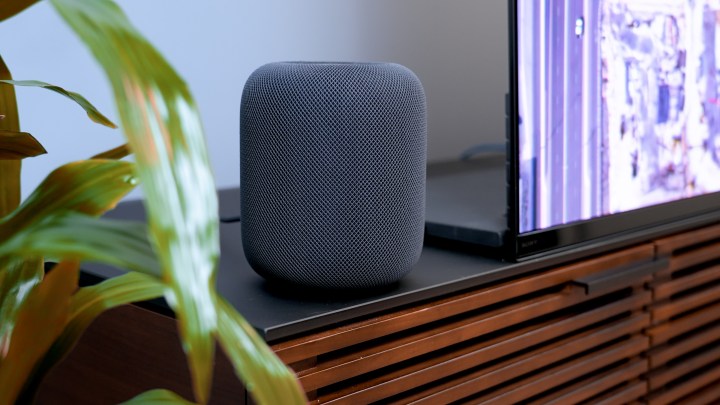
Zeke Jones / Digital Trends
Apple HomePod (2nd Gen)
Best soundbar alternative for Apple TV fans
Pros
Great sound quality
Incredible bass performance
Dazzling Spatial Audio surround
Plug and Play wireless
Slick design
Cons
Limited connection options
No direct Spotify playback
HomePod, the little Apple smart-speaker-that-could, made its triumphant return to store shelves early this year after the Cupertino company discontinued the original in 2021. It’s an excellent-sounding speaker that has improved upon the original in a number of ways, it’s packed with room-sensing tech that adapt the sound to basically anywhere you put it, and it’s a top-notch smart speaker with Matter support so it can work with and control all your home’s connected smart devices, such as lights, thermostats, and more.
So why, you might ask, is a smart speaker included on our list of the best soundbars? Because, as our intrepid Editor-at-Large, Caleb Denison, discovered in his review, when you pair two 2nd-gen HomePods together and add a new Apple TV 4K, the combination easily competes with soundbars, including the Sonos Beam. So much so that Denison called the experience “downright magical.”
And while there are definitely some differences between the more expensive HomePods + Apple TV 4K setup (roughly $750) and a $500 Sonos Beam (HDMI eARC is the big one missing from the HomePod), pairing a set of HomePods together offer not only excellent stereo sound separation when listening to movies (something that is harder to achieve with a soundbar), but Spatial Audio for movies and TV is amazing. “Dialogue is crystal clear and perfectly centered, sound effects are spacious and enveloping — I definitely got the impression there were more speakers in the room,” Denison gushed. Even the bass surprised him for a two-channel system, and if you want for a system that also does music just as well (or maybe you want to explore Dolby Atmos Music tracks, too), a set of HomePods might be worth a look.

Apple HomePod (2nd Gen)
Best soundbar alternative for Apple TV fans
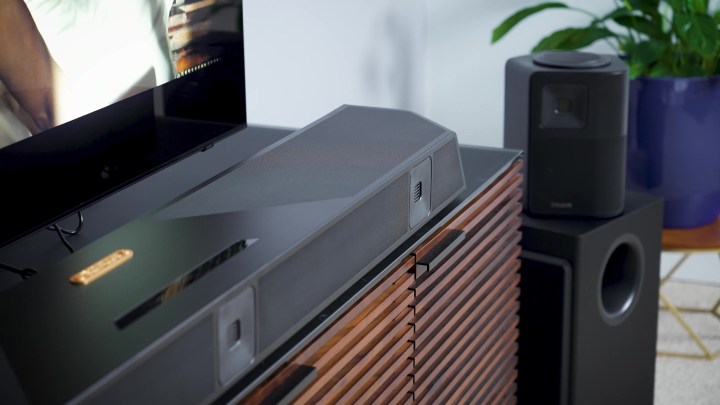
Zeke Jones/Digital Trends
Nakamichi Dragon 11.4.6 surround sound system
Best no-holds-barred, money-is-no-object soundbar
Pros
Supremely clean highs
Crystal-clear dialogue
Massively powerful
Seamless surround effects/object placement
Ridiculously fun
Cons
Lack of separate LFE and bass control
OSD could use better integration
Call it the dragon’s egg at the end of this best soundbars list, call it the beast that’ll burn a hole right through your wallet, call it what you want but whatever you do, don’t call the Nakamichi Dragon surround sound system for the faint of heart. We’ll try our best to describe it here, but it’s worth taking a few minutes for Caleb’s Denison’s video review, or watch him put it head to head with a Sonos Arc system to get the bigger picture about this $3,900 11.4.6 surround sound system.
First, though, the basics: the Nakamichi Dragon consists of a massive 58-inch soundbar unit that weight around 40 pounds and features 14 speakers and seven digital amplifiers. There are two 9-pound wireless surround sound speakers each with five drivers (side, rear, and up-firing), and two wireless subwoofers, each with two 8-inch drivers in them. Yeah, the total system output is 3,000 watts peaking at 125 decibels. Translation: loud.
The Nakamichi Dragon excels in volume, clarity, precision, soundstage, and just about every other audio-related term used to say “it sounds incredible” for both music and movies. But where it shines is in its abilities as a surround system, with support for Dolby Atmos and DTS:X. Through auditioning several surround sound examples, Denison noted the Dragon’s ability to immerse him in cavernous reverbs and pinpoint-accurate object placement around the room — sounds even seem to originate from places in the room where there are no speakers. Dialogue is clear and easy to understand (depending on the sound mix, of course), and explosive rumble comes with ease form the Dragon’s woofers.
Setup and calibration, while not for newbies, is pretty straightforward and id guided by a well-designed on-screen display that lets you select room size, EQing for games, movies, and more, as well as advanced calibration tools to get the system perfectly tuned for your uses.
Could you assemble a comparable system for less money? Of course you could. The $2,600 Sonos system (Arc soundbar, two Era 300s, one Sonos Sub), Denison compares the Dragon to in his video is roughly the same price (if you add a second Sub like the Dragon has, it’s $3,400), and there are obviously full Atmos receiver/speaker setups you could get into for less. But if you’ve got the money and are a little more serious about your home theater audio, few can compete with the impact and clarity of the Dragon at this price.

Nakamichi Dragon 11.4.6 surround sound system
Best no-holds-barred, money-is-no-object soundbar
Frequently Asked Questions
Why are soundbars so popular?
They offer a small footprint, they’re affordable and easy to set up, and they sound much better than the speakers built into most TVs.
How do soundbars work?
Virtually all modern soundbars connect to your TV via digital connection either with an optical or HDMI cable. The latter is generally preferred for TVs with HDMI ARC or eARC, as it allows for better sound and control of basic functionality with your TV remote. For Dolby Atmos, an HDMI connection is a prerequisite.
Can soundbars be controlled by a TV remote?
Some of them can be, yes. See the above for information about HDMI ARC.
Can soundbars be mounted on a wall?
Yes, many come with mounting brackets in the box, but almost all have optional wall-mount solutions you can buy later.
Can soundbars be mounted above a TV?
Technically yes, but we usually recommend mounting them below the TV. In general, we recommend you get them as close to ear level as possible for the best sound.
What about Wi-Fi and Bluetooth?
Most new soundbars do have this sort of wireless functionality. This typically allows you to stream music from your smartphone or home network directly to the soundbar. If a soundbar is also a smart speaker (e.g. Sonos Arc, Bose Soundbar 700) it will be Wi-Fi equipped.
Wi-Fi is generally preferable to Bluetooth for music streaming as its higher bandwidth supports higher quality formats like lossless FLAC, ALAC, WAV, and others. See the above question for wireless functionality with your TV or receiver.
Do soundbars always have a separate subwoofer?
No, not always. Some are built without them purposefully to save space. If they contain built-in subwoofers they can still deliver surprisingly strong bass, but most rely on a wired (or wireless) subwoofer for low-frequency sound.
Do soundbars support Alexa? Google Assistant? Siri?
Yes, but in slightly different ways. Some soundbars can double as smart speakers. The Sonos and Bose family of soundbars give you a choice of Google Assistant or Alexa, with the former also allowing you to use Sonos’ Voice Control.
Soundbars can also be voice assistant-compatible, which means that you’ll be able to use one or more voice assistants to control the soundbar if you already own a smart speaker or some other way to issue voice commands. Several soundbars can be added to Apple HomeKit, which lets you control them via Siri.
Still other soundbars, like Vizio’s family of products, have dedicated smart speaker inputs so you can wire a Google Nest Mini or Amazon Echo into the soundbar. This lets the soundbar understand when you are trying to talk to your assistant, and it can lower the speaker volume automatically while letting you hear the assistant via the higher-quality soundbar.
Does Apple make a soundbar?
No, but Apple’s HomePod Mini its resurrected 2nd Gen HomePod can act as soundbar replacements if you also own an Apple TV 4K. You can set up a set of HomePods as a stereo pair, which sounds amazing and might just be a good soundbar alternative.
Editors’ Recommendations
Best 70-inch TV deals: Get a big screen for sports for $450
Get this Vizio soundbar and wireless subwoofer for $139 today
The best Blu-ray players for 2023
The best HDMI switchers for 2023 to make the most of your TV’s inputs
Soundbar mega sale gets you better sound from just $45
>>> Read full article>>>
Copyright for syndicated content belongs to the linked Source : Digital Trends – https://www.digitaltrends.com/home-theater/best-soundbars/































